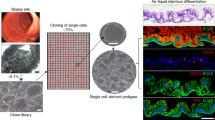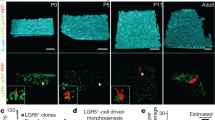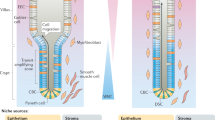Abstract
Adult intestinal epithelium consists of a sheet of single-cell thickness which is morphologically highly organized into tubular invaginations (crypts) and finger-like projections (villi). Proliferation of the cells is confined to the base of the crypts, from which cells migrate to the villi, where they are shed1. The villi are formed during embryogenesis from a multilayered epithelium2,3. In mice, crypts develop at about the time of birth from the epithelium between the villi, which by this stage is no longer multilayered. So far it has remained unknown how many progenitor cells contribute to each crypt, and whether they develop by the proliferation of already committed progenitors, or as a result of local inductive tissue interactions. Here, we have used mouse aggregation chimaeras as an experimental system to demonstrate immunohistochemically that the epithelium of individual crypts in small and large intestine of adult mice is always composed of cells of a single parental type. We have confirmed that this result is not an artefact of the chimaeric system by examining female mice that are mosaic for the X-linked alleles Pgk-1a and Pgk-1b. We conclude that the epithelium of each adult crypt is derived from a single progenitor cell.
This is a preview of subscription content, access via your institution
Access options
Subscribe to this journal
Receive 51 print issues and online access
$199.00 per year
only $3.90 per issue
Buy this article
- Purchase on Springer Link
- Instant access to full article PDF
Prices may be subject to local taxes which are calculated during checkout
Similar content being viewed by others
References
Potten, C.S. & Hendry, J.H. in Stem Cells (ed. Potten, C. S.) 155–199 (Churchill Livingstone, Edinburgh, 1983).
Trier, J. S. & Moxey, P. C. Ciba Fdn Symp. 70, 3–29 (1979).
Eastwood, G. L. & Trier, J. S. Anat. Rec. 179, 303–310 (1974).
Ponder, B. A. J., Wilkinson, M. M. & Wood, M. J. Embryol. exp. Morph 76, 83–93 (1983).
Ponder, B. A. J., Wilkinson, M. M., Wood, M. & Westwood, J. J. Histochem. Cytochem. 31, 911–919 (1983).
Ponder, B. A. J. & Wilkinson, M. M., Devl Biol. 96, 535–541 (1983).
McMahon, A., Foster, M. & Monk, M. J. Embryol. exp. Morph. 74, 207–220 (1983).
Cheng, H. & Leblond, C. P. Am. J. Anat. 141, 503–520 (1974).
Oi, V., Jones, P. P., Goding, J. W., Herzenberg, L. A. & Curr. Topics Microbiol. Immun. 81, 1–5 (1978).
Etzler, M. Enzymology 28, 340–344 (1972).
Schmidt, G. H., Ponder, B. A. J. & Wilkinson, M. M. Anat. Rec. 210, 407–411 (1984).
Schmidt, G. H., Garbutt, D., Wilkinson, M. M. & Ponder, B. A. J. J. Embryol. exp. Morph. (in the press).
Hutchinson, H. T. J. theor. Biol. 38, 61–79 (1973).
Whittingham, D. G. & Wales, R. G. Aust. J. boil. Sci. 22, 1065–1068 (1969).
Bucher, T., Bender, W., Fundele, R., Hofner, R. & Linke, I. FEBS Lett. 115, 319–324 (1980).
Author information
Authors and Affiliations
Rights and permissions
About this article
Cite this article
Ponder, B., Schmidt, G., Wilkinson, M. et al. Derivation of mouse intestinal crypts from single progenitor cells. Nature 313, 689–691 (1985). https://doi.org/10.1038/313689a0
Received:
Accepted:
Issue Date:
DOI: https://doi.org/10.1038/313689a0
This article is cited by
-
Cell fate specification and differentiation in the adult mammalian intestine
Nature Reviews Molecular Cell Biology (2021)
-
Tracing the cellular dynamics of sebaceous gland development in normal and perturbed states
Nature Cell Biology (2019)
-
Stem cell dynamics in homeostasis and cancer of the intestine
Nature Reviews Cancer (2014)
-
Adult intestinal stem cells: critical drivers of epithelial homeostasis and regeneration
Nature Reviews Molecular Cell Biology (2014)
-
Unravelling stem cell dynamics by lineage tracing
Nature Reviews Molecular Cell Biology (2013)
Comments
By submitting a comment you agree to abide by our Terms and Community Guidelines. If you find something abusive or that does not comply with our terms or guidelines please flag it as inappropriate.



